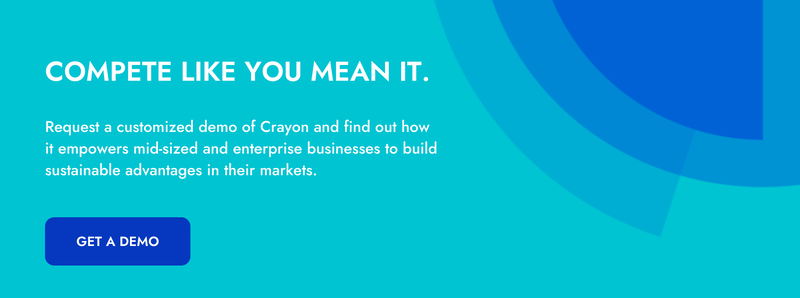We all know your stakeholders can benefit from competitive intelligence, but let’s talk about the real problem: They have so many places to look for information that, rather than looking, they’ll often just ask a colleague a question instead.
Sales. Customer Success. Product managers. Product marketers. Content marketers. Recruiters. Executive leaders. Each of these groups needs competitive intelligence, but the key to unlocking the value is continually reinforcing the “why they should care” message. You need to consistently deliver value in the context of the work that each group is doing day to day.
Now, if we zoom out and take a bird’s-eye view of all the different scenarios in which CI is useful, we can see that each of them falls into one of two buckets:
- Search mode: I’m trying to get something done, and I don’t have all the information I need.
- Awareness mode: As far as I know, I have all the information—but things change, and when they do, I need to be notified so I can react.
The key to success is meeting employees where they are, whether they’re in search mode or awareness mode. Crayon believes that your tech stack should connect in ways that make it easy to distribute and collect competitive intelligence, to and from every employee.
Using Crayon to optimize for search mode
An account executive on your sales team is chatting with a prospect. They think it’s a non-competitive opportunity—until the prospect mentions a feature that’s only offered by one company in your space.
“They must be evaluating Competitor X,” your AE thinks. “Good to know.”
When the call ends, your AE enters search mode: How can I follow up with this prospect in a way that positions us as a better solution than Competitor X?
Thanks to you, it’s a quick and painless search. Using Crayon, you integrated your battlecards into your Salesforce opportunity records. So, in a matter of seconds, your AE is able to find the Competitor X battlecard, open it, and check out the leaderboard—a list of peers who have recently had success against this competitor.
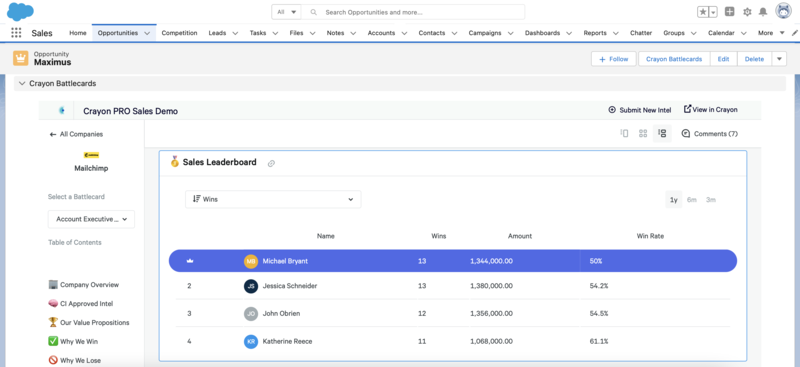
This embedded battlecard experience can be easily replicated in HubSpot, Freshsales, Seismic, Showpad, and anywhere else your sellers spend their time.
After a quick exchange on Slack, your AE has everything they need to write the best follow-up email possible, improving their chances of winning this competitive opportunity—nicely done!
You may wonder: What if your AE forgets to look for this battlecard after the call ends? Better yet, what if they don’t pick up on the signal that this is a competitive opportunity?
Not a problem. As long as you’ve connected Crayon and Gong, your AE will be greeted first thing in the morning by their Competitive Mentions Daily Recap—a personalized directory of competitive insights based on the previous day’s conversations:
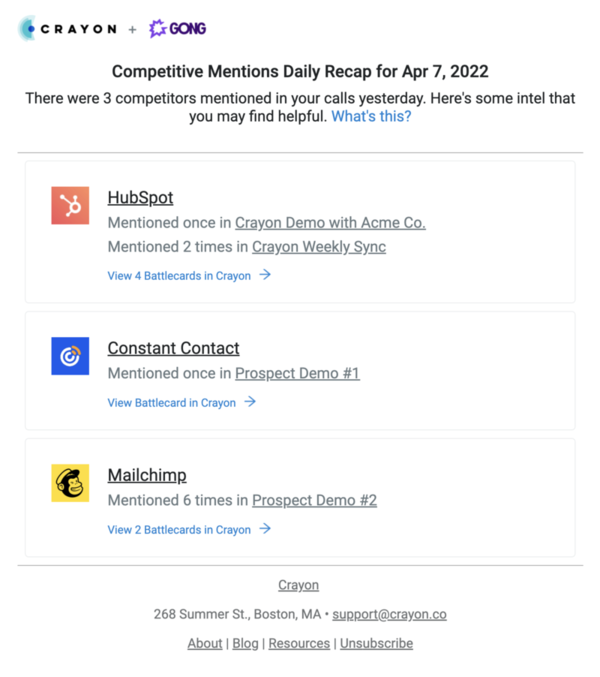
Meanwhile, your Director of Content Marketing is also in search mode. They’re trying to determine which themes to focus on next quarter—which brings questions to their mind: What topics have our competitors been discussing recently? Are they overlooking anything?
This, too, is a quick and painless search. Using Crayon, you created a dedicated marketing dashboard—featuring a word cloud representation of your competitors’ recent blog posts—and embedded it in Confluence. So, without leaving the app they use to manage the editorial calendar, your content leader finds answers to their questions, ensuring that their output remains differentiated throughout the coming months.
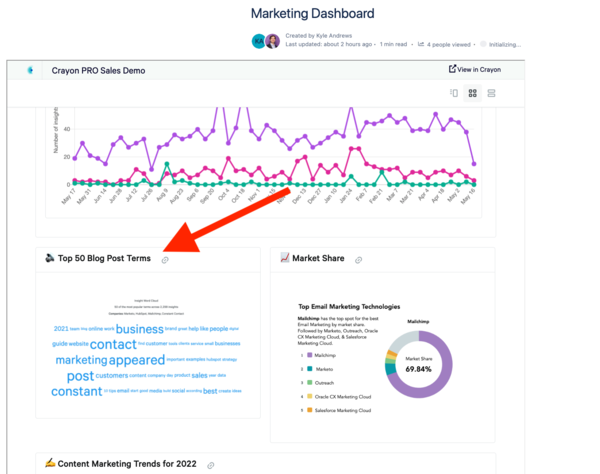
This embedded dashboard experience can be easily replicated in SharePoint, Teams, ClickUp, Notion, and anywhere else your colleagues spend their time.
Using Crayon to optimize for awareness mode
You’ve been working hard to create talk tracks that your sellers can use when they’re competing against a company called Wix. One of these talk tracks is designed to be used when the prospect works for a large company, and it includes the claim that Wix is “primarily a small business tool.”
A few days before you’re scheduled to train your sellers on this very talk track, you get an alert from Crayon, delivered straight to your product marketing Slack channel in real time:

This real-time alert experience can be easily replicated in Microsoft Teams.
There’s no way you could’ve known to look for this information—and that’s precisely the reason you connected Crayon and Slack. When there’s something you need to know, but you don’t know that you need to know it, our Slack integration has you covered.
Meanwhile, your CEO has been working hard to create a presentation for an upcoming board meeting, with a handful of slides dedicated to updates on your competitive landscape. You think to yourself: “I’d better let them know about this Wix news. If the board asks about it and they don’t have an answer, it’s going to look bad.”
Knowing that your CEO lives in their inbox, you open the Wix news in Crayon, add context, and send it their way. Moments later, as they’re putting the finishing touches on their presentation, they see this:
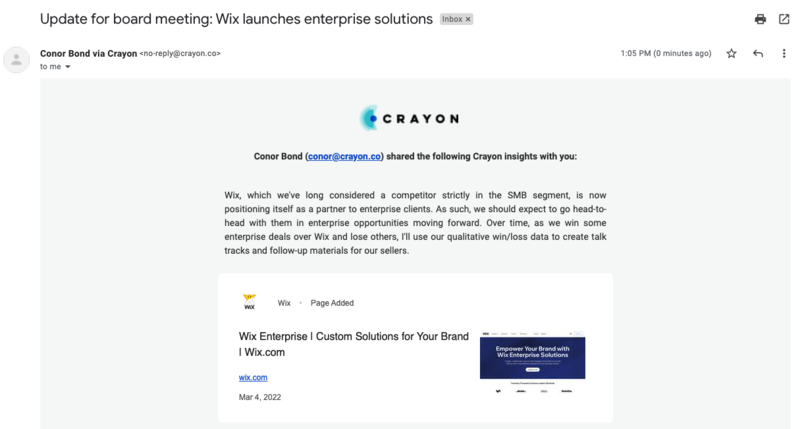
From your Crayon portal, to your product marketing Slack channel, to your CEO’s inbox—all in a matter of minutes. Thanks to your use of Crayon’s integrations, you’re better prepared to enable your sales team and your CEO is better prepared to address the board. Everyone wins!
See for yourself
As you’re reading this, you have colleagues in both search mode and awareness mode. To take a closer look at the ways in which Crayon can help you give everyone exactly what they need—exactly when they need it—click the banner below and check out a demo today.

Related Blog Posts
Popular Posts
-
 How to Create a Competitive Matrix (Step-by-Step Guide With Examples + Free Templates)
How to Create a Competitive Matrix (Step-by-Step Guide With Examples + Free Templates)
-
 The 8 Free Market Research Tools and Resources You Need to Know
The 8 Free Market Research Tools and Resources You Need to Know
-
 Sales Battlecards 101: How to Help Your Sellers Leave the Competition In the Dust
Sales Battlecards 101: How to Help Your Sellers Leave the Competition In the Dust
-
 6 Competitive Advantage Examples From the Real World
6 Competitive Advantage Examples From the Real World
-
 How to Measure Product Launch Success: 12 KPIs You Should Be Tracking
How to Measure Product Launch Success: 12 KPIs You Should Be Tracking

